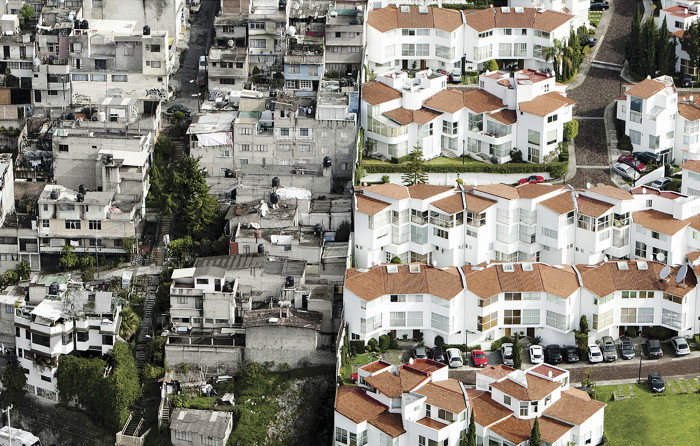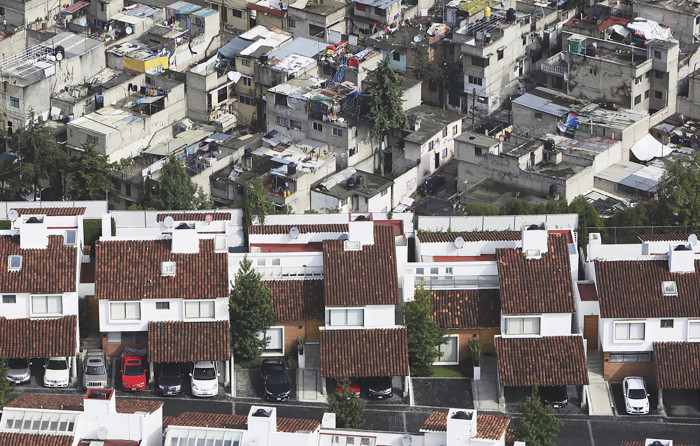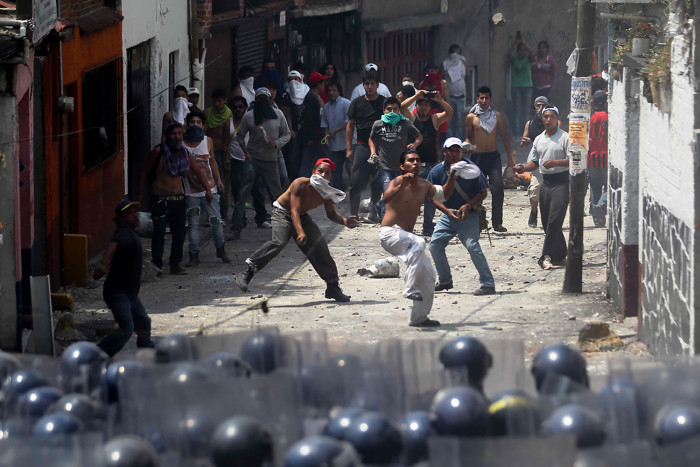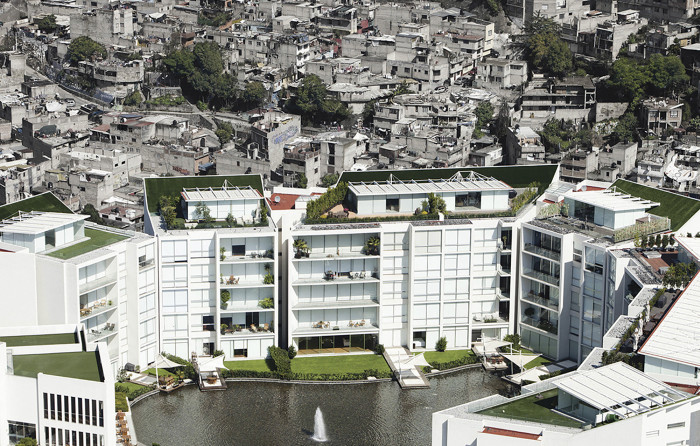
05.12.2016
Larger issues at stake brought to light by action censored in mainstream coverage.

Civil resistance and utopia in Santa Fe, Mexico City.
Last night, a group of about 4000 precarious workers, representatives of displaced students, activists, cultural producers, as well as people from San Mateo Tlaltenango, Santa Rosa Xochiac, San Bartolo Ameyalco, San Bernabé, San Lorenzo Acopilco, La Magdalena, amongst other communities and towns, took over the Santa Fe mall in the business district of the same name located in the Western part of Mexico City. With the complicity of personnel working for the security company sub-contracted by the mall’s administration, the invaders were able to break into the facility at around 1:00 AM. The action was inspired by the 2001 Mayday Parade takeover of the Metropoli di Novate mall in Milano, and by the rolezinhos, in São Paulo and Rio de Janeiro in 2014. In the rolezinhos (or “little strolls”) teenagers from the urban periphery used social media to organize excursions in malls. In these non-politicized actions, the teenagers sought to have fun and meet people. Causing terror amongst the shop owners, mall administrators and upper-class frequenters of these spaces, the sudden appearance of hundreds of people of color in shopping malls in Brazil immediately brought to the table the issues of public space and entitlement, life in the periphery and privilege.
Along the same lines as the mall take over in Milano and the rolezinhos, the group that broke into the Santa Fe mall did not only seek to bring visibility to the precarization of labor, economic crisis, massive dispossession and displacement of campesinos and inhabitants of urban peripheries. The action also shed light to asymmetrical access to goods, infrastructure and services, the devastation of forms of life and ways of making a living within neoliberal policies, and lack of working-class housing throughout Mexico City. At the same time, the group wanted to put alternatives to the current corporate-capitalist system on the table, while highlighting the fact that autonomy for the rich is supported by the state (the Santa Fe ZEDEC, Zona Especial de Desarrollo Económico, is a de facto self-governed legal territorial figure since 1994), while autonomy for the poor is repressed. In an exercise of translation of Zapatista autonomy exercises to peripheral urban areas, they outlined their struggle as one for human rights, justice and dignity, communal economies, education for autonomy, food sovereignty, indigenous and community communication all based on horizontality, solidarity, self-management, voluntary work, and consensus. They also sought to represent localized struggles against the government and national and transnational corporations and their megaprojects by putting to the forefront the defense of the land in San Mateo Tlaltenango and of the water in San Bartolo Ameyalco.
As soon as the group came inside the mall, they got busy assembling a life-size blueprint of the space inspired by the imperial map in Jorge Luis Borges’ short story On the Exactitude of Science. The model proposed a de-colonized version of the shopping center, reusing its architecture as the basis of a new autonomous, communal economy. In the plan, the children’s entertainment complex premised on transforming kids into entrepreneurs and consumers, “Kidzania,” is replaced by an assembly hall; “Palacio de Hierro” which becomes a learning center and host for an archive of the memories of the displaced indigenous peoples’ who have lived in the city for four generations or more; “Liverpool” would be a health and education center of traditional and alternative medicine; “Sears,” an education and research complex for recuperating aboriginal forms of knowledge and knowledge transmission. Most of the retail spaces are to be re-converted to housing spaces and facilities for raising cattle and chicken and for other subsistence needs for about 600 families. A park replaces the parking lot along with a barter market and time bank. The roof is devoted to an enormous urban garden and grasshopper farm, the community’s main source of protein. A pirate radio station is envisioned, and a memory commission is assigned to write the history of indigenous peoples from their perspective. The same group of French-Algerian and German-Turkish anthropologists that is now working on the Acapulco-Diamante takeover project, was involved in the design of the plan for the Santa Fe mall, along with a team of experts in sustainability and alternative energies.
Once the group expediently set up the blueprint along with signs and banners explaining how the new autonomous communal space and economy would function, at around 2.30 AM they climbed up on the roof to have a nocturnal picnic and dance. At around 2:45 AM police officers landed on the mall’s rooftop from helicopters and used tear gas and bullets to disperse the crowd; although no arrests occurred inside the shopping mall, some 20 people have been reported dead, about 150 wounded.
In the face of the threat posed by this attempted takeover, a government program will be instituted for the residual populations that remain trapped in the periphery of privilege and progress of the Santa Fe ZEDEC titled: “Periphery as Cultural Patrimony.” A team of social architects, experts in sustainable building, and a historical urban landscape manager will begin to work on specific projects to better these people’s lives with consensual site-specific interventions along with social programs in housing, health and education. The program will be generously funded by the SoroSlim and Televisa Foundations.

The area where the Santa Fe mall is located, West of Mexico City, used to lodge a sand mine and from the mid 20th century on, it became a landfill. At the end of the 1970s, a trust was funded in Santa Fe and in 1993 a new legal figure tied to the land use was created: the “ZEDEC” (Zona Especial de Desarrollo Económico) or Special Zone of Controlled Economic Development. The Trust Fund was created under the premise that the Federal District’s Government would guarantee urban development and provide investors with electricity, infrastructure, roads, water, and pipelines so they could install their industry in the future Santa Fe ZEDEC. Members of the Santa Fe Trust Fund were national and international corporations, owners of private universities and schools, and real estate developers. The Trust Fund set the premise to institute a new model for territorial governance combining the private and public. This then led to the Santa Fe Settlers Trust, a body comprised of 7 members, four of whom are designated by the association, 3 by the government and decisions on the territory are taken based on the majority of votes. In parallel, the very same year of the Zapatista uprising, the Santa Fe ZEDEC Settlers Association was created by investors and inhabitants seeking to create a common front against the problems they encountered in the area. For instance, surrounded by deep ravines and precipices, the area needs to be interconnected by bridges, which are not always built by the State when needed. Or, the remaining landfill on hard soil makes the water pipes vulnerable to contamination, and the trash residues in the soil produce flammable gases that need to be periodically liberated with a lot of care. The goals of the Association are therefore focused on land use, rescuing public space and green areas, environmental protection, providing better infrastructure and urban services, and it has laid out a mobility plan that includes a Toluca-Mexico City train, as well as a defense of the ravines. The Association posits itself as “a social services private corporation,” and they follow up on the construction of new buildings, they make sure that the land use normativity is followed, and “promote legality and the common good in Santa Fe.” The Association represents all the investors, inhabitants and workers of the area before the authorities to assure better development and conservation of the zone; it considers itself to be a-political, non-profit, and devoted to promoting proactive participation of the inhabitants in the different government orders. All to realize better quality of life, and the preservation of urban infrastructure, public space, public services and the environment for those in Santa Fe.
The legal figure of the ZEDEC, the Santa Fe Settler’s Association and the Santa Fe Trust Fund are all bodies that govern the territory in formal collaboration with the government. In a way, they are new models of autonomy that combine private management with governmental support. That is to say, these organizational figures allow for the private sector to make its own decisions regarding territorial policies, to lobby for its own interests and to ensure its privileges and the creation of surplus value with the support of the State. The Santa Fe Settlers Association encompasses corporations, restaurants, educational institutions, housing settlements and shopping malls and has declared as independent the territory of 1000 “developed” hectares in the Álvaro Obregón and Cuajimalpa districts. According to the Association, this area belongs to neither district and so the trust was geared in 2004 to achieve “private self-management,” collecting a percentage of the property taxes from the area, to decide what infrastructure, maintenance and security projects will take place locally. Rumors state that many of the inhabitants of the Santa Fe ZEDEC, which comprises 75 office buildings, 4 shopping malls, 4000 apartments in condominiums, 1500 homes, 5 hotels, 7 universities and schools, have never had to pay for water.
Santa Fe turned out to be a luxury urban housing development built on communal lands bought very cheaply in illegal macro sales once Ex-President Carlos Salinas de Gortari enabled the privatization of traditional communal lands (or ejidos). Since the Santa Fe ZEDEC project began, thousands of aboriginal peoples and the descendants of campesino immigrants to the city have lost their patrimony and life sources and are now being harassed by corporations and the government in an ongoing struggle for land and the commons. Since the 1970s, there have been subsequent expulsions and displacements of the inhabitants from communities such as La Rosita, Cruz Manca, Cruz de Palo whom have had to move to other communities like San José de los Cedros, San Mateo Tlaltenango and Navidad in Cuajimalpa. La Viñita, a community of trash scavengers living off the landfill until the 1990s, has completely disappeared.

Like the ZEDEC as a legal territorial figure that conveys autonomy to the private sector, the Santa Fe Trust Fund and the Santa Fe Settlers’ Association, some of the older inhabitants of the area have attempted to establish autonomous forms of governance to defend themselves from destructive, inefficient or unequal government policies that are dispossessing and forcefully displacing them. For instance, the inhabitants of San Mateo Tlaltenango have been spectators of a real estate boom in their lands, which have been gradually stolen because they have never been recognized by the State as landowners. And yet, ownership of their lands dates back to the colonial era as part of an Aztec calpulli in the lands of the Anáhuac, as described by the Techialoyan Codex, on the road to Cauauximalpan (Cuajimalpa). In 1979, the Iberoamericana University began to build its campus on their lands and in 2011 they founded a movement, “Natives and Naturals of San Mateo Tlaltenango” to demand recognition of land ownership and confirmation and entitlement of communal, bearing a document dating from 1704, a “Merced Real” which proves the extension of their territory. Government authorities, however, have ignored them and repressed the resistance with massive police violence since 2014. For the moment, the inhabitants of San Bartolo have an amparo or an order for protection against the action of the authorities. Their struggle also encompasses food sovereignty, community water management, soil conservation and their right to autonomy. Communities that are also part of the property conflict are Santa Rosa Xochiac, San Bartolo Ameyalco, San Bernabé, San Lorenzo Acopilco, La Magdalena as well as the Ocotal Forest, el Cedral, Loma de Pachuquilla and the ecological reserve Desierto de Los Leones. The problem is that the government is managing their land while squatter settlements continue to grow, making divisions amongst the communities prevail.
Paradoxically, the native peoples’ right to autonomy is denied and repressed (such as the cases of autonomous municipalities across the country like the Zapatista Caracoles, San Juan Copala or Cherán in Michoacán, Tlaltenanco and Ameyalco), while the Federal District’s government and the Santa Fe Settler’s Association and Trust Fund have considered creating a new political district (delegación) in the area, as a way to validate the almost self-government of the zone by the Trust and Association that manages it. The new political district, however, would only encompass residential and commercial zones that yield high surplus value and would exclude the lower income areas lodged in its periphery, which, from the point of view of the Santa Fe Trust Fund, are part of the problem. One of the Settlers’ key concern is that access to the commercial and housing areas in Santa Fe is necessarily through the peripheral, less developed areas. This is why the Santa Fe Settlers Association, financed by the SoroSlim Foundation, has invited a team of Israeli urban and landscape planners to present solutions similar to those they have applied in the West Bank to safely and efficiently interconnect the Israeli settlements scattered throughout.

The autonomy model embodied by ZEDEC also has a parallel in the struggle of an adjacent town and it’s expropriated peoples, the inhabitants of San Bartolo Ameyalco in the Álvaro Obregón District. By March 2015, water had ceased to reach some of the people’s homes, as water stopped circulating inside their water pipes. And yet, they could hear the liquid running beneath their feet coming from the water source in their land. That is, in the town of Ameyalco there is a water source that has supplied the population for centuries; for the past 15 years, they have been fighting to keep it. The newcomers as well as settlement expansions in Santa Fe have caused the illegal re-channeling of their source to the ZEDEC in 2014 by the government. That year, the inhabitants of San Bartolo Ameyalco stopped the State’s hydraulic works, self-organized, and refused to allow federal elections to take place in their community. On May 21 that year, however, they underwent violent police aggression after the deployment of 1500 riot police. Five members of the community were imprisoned under charges of “threatening public peace” and have not been able to get out on bail. Activists and other community members have disappeared since, while the community’s inhabitants are now forced to pay for water delivered by pipas or trucks to their homes.
The background story of the Santa Fe Mall Takeover involves the paradox of unequal access to autonomous forms of government and political determination. While the privileges of a few are costing the commons and lives and forms of life of the less privileged, a political matter that concerns us all, the government is punishing popular forms of autonomy while facilitating corporate-backed forms of self-government of the more privileged sectors of the population. The Takeover also evidences the limits of symbolic political action and the fact that beyond a critique of consumerism and corporativism, what is at sake is a differential valuing of life that is making aboriginal, indigenous or poor people even more vulnerable. A few hours after the occupiers were dislodged from the Santa Fe shopping mall, communities in the periphery of the ZEDEC began to suffer police raids with repression, arrests and illegal disappearances.
Comments
There are no coments available.